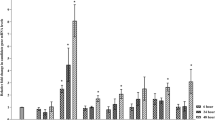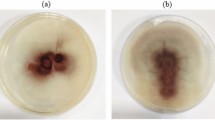Abstract
As one of the most devastating diseases of rice, sheath blight causes severe rice yield loss. However, little progress has been made in rice breeding for sheath blight resistance. It has been reported that polygalacturonase inhibiting proteins can inhibit the degradation of the plant cell wall by polygalacturonases from pathogens. Here, we prokaryotically expressed and purified OsPGIP1 protein, which was verified by Western blot analysis. Activity assay confirmed the inhibitory activity of OsPGIP1 against the PGase from Rhizoctonia solani. In addition, the location of OsPGIP1 was determined by subcellular localization. Subsequently, we overexpressed OsPGIP1 in Zhonghua 11 (Oryza sativa L. ssp. japonica), and applied PCR and Southern blot analysis to identify the positive T0 transgenic plants with single-copy insertions. Germination assay of the seeds from T1 transgenic plants was carried out to select homozygous OsPGIP1 transgenic lines, and the expression levels of OsPGIP1 in these lines were analyzed by quantitative real-time PCR. Field testing of R. solani inoculation showed that the sheath blight resistance of the transgenic rice was significantly improved. Furthermore, the levels of sheath blight resistance were in accordance with the expression levels of OsPGIP1 in the transgenic lines. Our results reveal the functions of OsPGIP1 and its resistance mechanism to rice sheath blight, which will facilitate rice breeding for sheath blight resistance.




Similar content being viewed by others
References
Aguero CB, Uratsu SL, Greve C, Powell ALT, Labavitch JM, Meredith CP, Dandekar AM (2005) Evaluation of tolerance to Pierce’s disease and Botrytis in transgenic plants of Vitis vinifera L. expressing the pear PGIP gene. Mol Plant Pathol 6:43–51
Albersheim P, Anderson AJ (1971) Proteins from plant cell walls inhibit polygalacturonases secreted by plant pathogens. Proc Natl Acad Sci USA 68:1815–1819
Alghisi P, Favaron F (1995) Pectin-degrading enzymes and plant-parasite interactions. Eur J Plant Pathol 101:365–375
Chen H, Tang W, Xu C, Li X, Lin Y, Zhang Q (2005) Transgenic indica rice plants harboring a synthetic cry2A* gene of Bacillus thuringiensis exhibit enhanced resistance against lepidopteran rice pests. Theor Appl Genet 111:1330–1337
Chen X, Wang Y, Zuo S, Tong Y, Pan X, Xu J (2010) Isolation, purification and characterization of polygalacturonase (PG) from Rhizoctonia solani, the pathogen of rice sheath blight. Acta Phytopathol Sin 40:276–281
De Lorenzo G, D’Ovidio R, Cervone F (2001) The role of polygalacturonase-inhibiting proteins (PGIPs) in defense against pathogenic fungi. Annu Rev Phytopathol 39:313–335
Ferrari S, Vairo D, Ausubel FM, Cervone F, De Lorenzo G (2003) Tandemly duplicated Arabidopsis genes that encode polygalacturonase-inhibiting proteins are regulated coordinately by different signal transduction pathways in response to fungal infection. Plant Cell 15:93–106
Ferrari S, Sella L, Janni M, De Lorenzo G, Favaron F, D’Ovidio R (2012) Transgenic expression of polygalacturonase-inhibiting proteins in Arabidopsis and wheat increases resistance to the flower pathogen Fusarium graminearum. Plant Biol 14:31–38
Fielding AH (1981) Natural inhibitors of fungal polygalacturonases in infected fruit tissues. J Gen Microbiol 123:377–381
Gotoh Y, Nalumpang S, Isshiki A, Utsumi T, Kenji G, Yamamoto H, Akimitsu K (2002) A cDNA encoding polygalacturonase-inhibiting protein induced in citrus leaves by polygalacturonase of Alternaria citri. J Gen Plant Pathol 68:57–61
Helliwell EE, Wang Q, Yang Y (2013) Transgenic rice with inducible ethylene production exhibits broad-spectrum disease resistance to the fungal pathogens Magnaporthe oryzae and Rhizoctonia solani. Plant Biotechnol J 11:33–42
Hiei Y, Ohta S, Komari T, Kumashiro T (1994) Efficient transformation of rice (Oryza sativa L.) mediated by Agrobacterium and sequence analysis of the boundaries of the T-DNA. Plant J 6:271–282
Hu D, Dai R, Wang Y, Zhang Y, Liu Z, Fang R, Zhao W, Li L, Lin Q, Li L (2012) Molecular cloning, sequence analysis, and expression of the polygalacturonase-inhibiting protein (PGIP) gene in mulberry. Plant Mol Biol Rep 30:176–186
Hwang BH, Bae H, Lim HS, Kim KB, Kim SJ, Im MH, Park BS, Kim J (2010) Overexpression of polygalacturonase-inhibiting protein 2 (PGIP2) of Chinese cabbage (Brassica rapa ssp. pekinensis) increased resistance to the bacterial pathogen Pectobacterium carotovorum ssp. carotovorum. Plant Cell Tiss Org 103:293–305
Jang S, Lee B, Kim C, Kim SJ, Yim J, Han JJ, Lee S, Kim SR, An G (2003) The OsFOR1 gene encodes a polygalacturonase-inhibiting protein (PGIP) that regulates floral organ number in rice. Plant Mol Biol 53:357–372
Janni M, Di Giovanni M, Roberti S, Capodicasa C, D’Ovidio R (2006) Characterization of expressed Pgip genes in rice and wheat reveals similar extent of sequence variation to dicot PGIPs and identifies an active PGIP lacking an entire LRR repeat. Theor Appl Genet 113:1233–1245
Janni M, Sella L, Favaron F, Blechl AE, De Lorenzo G, D’Ovidio R (2008) The expression of a bean PGIP in transgenic wheat confers increased resistance to the fungal pathogen Bipolaris sorokiniana. Mol Plant Microbe In 21:171–177
Janni M, Bozzini T, Moscetti I, Volpi C, D’Ovidio R (2013) Functional characterisation of wheat Pgip genes reveals their involvement in the local response to wounding. Plant Biology 15:1019–1024
Joubert DA, Slaughter AR, Kemp G, Becker JVW, Krooshof GH, Bergmann C, Benen J, Pretorius IS, Vivier MA (2006) The grapevine polygalacturonase-inhibiting protein (VvPGIP1) reduces Botrytis cinerea susceptibility in transgenic tobacco and differentially inhibits fungal polygalacturonases. Transgenic Res 15:687–702
Li Z, Pinson SRM, Marchetti MA, Stansel JW, Park WD (1995) Characterization of quantitative trait loci (QTLs) in cultivated rice contributing to field resistance to sheath blight (Rhizoctonia solani). Theor Appl Genet 91:382–388
Lin Y, Zhang Q (2005) Optimising the tissue culture conditions for high efficiency transformation of indica rice. Plant Cell Rep 23:540–547
Liu G, Jia Y, Correa-Victoria FJ, Prado GA, Yeater KM, McClung A, Correll JC (2009) Mapping quantitative trait loci responsible for resistance to sheath blight in rice. Phytopathology 99:1078–1084
Livak KJ, Schmittgen TD (2001) Analysis of relative gene expression data using real-time quantitative PCR and the 2−ΔΔCT Method. Methods 25:402–408
Lu L, Zhou F, Zhou Y, Fan X, Ye S, Wang L, Chen H, Lin Y (2012) Expression profile analysis of the polygalacturonase-inhibiting protein genes in rice and their responses to phytohormones and fungal infection. Plant Cell Rep 31:1173–1187
Manfredini C, Sicilia F, Ferrari S, Pontiggia D, Salvi G, Caprari C, Lorito M, Lorenzo GD (2005) Polygalacturonase-inhibiting protein 2 of Phaseolus vulgaris inhibits BcPG1, a polygalacturonase of Botrytis cinerea important for pathogenicity, and protects transgenic plants from infection. Physiol Mol Plant P 67:108–115
Mao B, Liu X, Hu D, Li D (2014) Co-expression of RCH10 and AGLU1 confers rice resistance to fungal sheath blight Rhizoctonia solani and blast Magnorpathe oryzae and reveals impact on seed germination. World J Microbiol Biotechnol 30:1229–1238
Mishra AK, Sharma K, Misra RS (2012) Elicitor recognition, signal transduction and induced resistance in plants. J Plant Interact 7:95–120
Murray MG, Thompson WF (1980) Rapid isolation of high molecular weight plant DNA. Nucleic Acids Res 8:4321–4326
Nalumpang S, Gotoh Y, Tsuboi H, Kenji G, Yamamoto H, Akimitsu K (2002) Functional characterization of citrus polygalacturonase-inhibiting protein. J Gen Plant Pathol 68:118–127
Oelofse D, Dubery IA, Meyer R, Arendse MS, Gazendam I, Berger DK (2006) Apple polygalacturonase inhibiting protein1 expressed in transgenic tobacco inhibits polygalacturonases from fungal pathogens of apple and the anthracnose pathogen of lupins. Phytochemistry 67:255–263
Pinson SRM, Capdevielle FM, Oard JH (2005) Confirming QTLs and finding additional loci conditioning sheath blight resistance in rice using recombinant inbred lines. Crop Sci 45:503–510
Poland JA, Balint-Kurti PJ, Wisser RJ, Pratt RC, Nelson RJ (2009) Shades of gray: the world of quantitative disease resistance. Trends Plant Sci 14:21–29
Powell ALT, Van Kan J, Ten Have A, Visser J, Greve LC, Bennett AB, Labavitch JM (2000) Transgenic expression of pear PGIP in tomato limits fungal colonization. Mol Plant Microbe In 13:942–950
Richter A, Jacobsen HJ, De Kathen A, De Lorenzo G, Briviba K, Hain R, Ramsay G, Kiesecker H (2006) Transgenic peas (Pisum sativum) expressing polygalacturonase inhibiting protein from raspberry (Rubus idaeus) and stilbene synthase from grape (Vitis vinifera). Plant Cell Rep 25:1166–1173
Savary S, Castilla NP, Elazegui FA, McLaren CG, Ynalvez MA, Teng PS (1995) Direct and indirect effects of nitrogen supply and disease source structure on rice sheath blight spread. Phytopathology 85:959–965
Savary S, Willocquet L, Elazegui FA, Castilla NP, Teng PS (2000) Rice pest constraints in tropical Asia: quantification of yield losses due to rice pests in a range of production situations. Plant Dis 84:357–369
Shah JM, Raghupathy V, Veluthambi K (2009) Enhanced sheath blight resistance in transgenic rice expressing an endochitinase gene from Trichoderma virens. Biotechnol Lett 31:239–244
Shanmugam V (2005) Role of extracytoplasmic leucine rich repeat proteins in plant defence mechanisms. Microbiol Res 160:83–94
Simpson CG, MacRae E, Gardner RC (1995) Cloning of a polygalacturonase inhibiting protein from Kiwifruit (Actinidia deliciosa). Plant Physiol 108:1748
Slaton NA, Cartwright RD, Meng J, Gbur EE, Norman RJ (2003) Sheath blight severity and rice yield as affected by nitrogen fertilizer rate, application method, and fungicide. Agron J 95:1489–1496
Szankowski I, Briviba K, Fleschhut J, Schönherr J, Jacobsen HJ, Kiesecker H (2003) Transformation of apple (Malus domestica Borkh.) with the stilbene synthase gene from grapevine (Vitis vinifera L.) and a PGIP gene from kiwi (Actinidia deliciosa). Plant Cell Rep 22:141–149
Taguchi-Shiobara F, Ozaki H, Sato H, Maeda H, Kojima Y, Ebitani T, Yano M (2013) Mapping and validation of QTLs for rice sheath blight resistance. Breed Sci 63:301–308
Tamburino R, Chambery A, Parente A, Di Maro A (2012) A novel polygalacturonase-inhibiting protein (PGIP) from Lathyrus sativus L. seeds. Protein Pept Lett 19:820–825
Tamura M, Gao M, Tao R, Labavitch JM, Dandekar AM (2004) Transformation of persimmon with a pear fruit polygalacturonase inhibiting protein (PGIP) gene. Sci Hortic 103:19–30
Toubart P, Desiderio A, Salvi G, Cervone F, Daroda L, Lorenzo G, Bergmann C, Darvill AG, Albersheim P (1992) Cloning and characterization of the gene encoding the endo polygalacturonase-inhibiting protein (PGIP) of Phaseolus vulgaris L. Plant J 2:367–373
Vorwerk S, Somerville S, Somerville C (2004) The role of plant cell wall polysaccharide composition in disease resistance. Trends Plant Sci 9:203–209
York WS, Darvill AG, McNeil M, Stevenson TT, Albersheim P (1985) Isolation and characterization of plant cell walls and cell wall components. Methods Enzymol 118:3–40
Zuo S, Zhang Y, Yin Y, Chen Z, Pan X (2006) Establishment and improvement of inoculation technique and rating system in researching rice sheath blight resistance in field. J Yangzhou Univ 27:57–61
Zuo S, Yin Y, Zhang L, Zhang Y, Chen Z, Pan X (2007) Breeding value and further mapping of a QTL qSB-11 conferring the rice sheath blight resistance. Chin J Rice Sci 21:136–142
Acknowledgments
We are grateful to Yangzhou University for their support of field testing of sheath blight resistance. This research was supported by the National Program of Transgenic Variety Development of China, the National Special Key Project for Transgenic Breeding (2014ZX0800103B), the National High Technology Research and Development Program of China (863 Program) and the National Natural Science Foundation of China. We also thank Prof. Zuoxiong Liu for language improvement.
Conflict of interest
We declare that no conflict of interest exists for any of the authors.
Author information
Authors and Affiliations
Corresponding author
Electronic supplementary material
Below is the link to the electronic supplementary material.
11103_2014_269_MOESM1_ESM.jpg
Expression pattern of OsPGIP1 in different tissues of rice. RT-PCR was performed on total RNAs using gene-specific primers and the amplification products were separated on 1.5% agarose gel (JPEG 138 kb)
Rights and permissions
About this article
Cite this article
Wang, R., Lu, L., Pan, X. et al. Functional analysis of OsPGIP1 in rice sheath blight resistance. Plant Mol Biol 87, 181–191 (2015). https://doi.org/10.1007/s11103-014-0269-7
Received:
Accepted:
Published:
Issue Date:
DOI: https://doi.org/10.1007/s11103-014-0269-7




